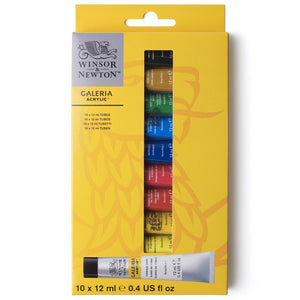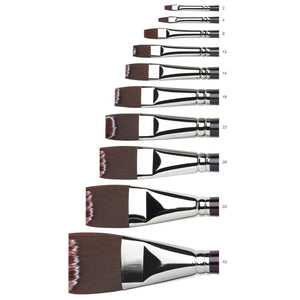
THE ARTIST
Glyn Macey
Glyn Macey was born in Cornwall, UK and completed his HND in Graphic Design at Falmouth School of Art in 1991. He also worked as a successful designer until 1998 when he 'retired' from designing to devote his time solely to painting.

Step 1
Water down a squeeze of Process Cyan to the consistency of single cream. This is used to block in the sky and sea areas. Note how areas of the painting appear darker than others. This is due to the paint being applied heavier towards the horizon in the sea and towards the bottom of the sky. Follow the same process using yellow ochre for the shore area.

Step 2
When completely dry, add a wash of Ultramarine to the top of the sky, again using the single cream consistency. Note how the Ultramarine ‘glazes’ over the Process Cyan giving a jewel like depth. Use the same process, using a wash of Permanent Green to the sea area to create wonderful aquas.

Step 3
Next, mix a little Mars Black to some Process Magenta. This will give you a rich dark, the colour of shore seaweeds. Use the brush to scumble (rub) the dark along the edge of the shoreline to create a more dramatic edge.

Step 4
Using Titanium White straight from the tube, add crested wave marks using the painting knife. Experiment using the different edges of the knife for a variety of mark making. Keep the larger marks towards the shore and the smaller marks towards the distant, darker sea.

Step 5
As you add more Titanium White towards the shore you will find that it can mix with the dark ‘seaweed’ if still wet. This process can be used to create beautiful tones and interest.

Step 6
Mix a tiny touch of Process Cyan with a good amount of Titanium White to create a pale blue. This can be used to help straighten the horizon and to add light and interest into the sky. Finally, to create a focal point and movement, add a few simple sail shapes using the painting knife loaded with Titanium White.














![WN PWC KAREN KLUGLEIN BOTANICAL SET [OPEN 3]](http://www.winsornewton.com/cdn/shop/files/136448.jpg?crop=center&v=1724423264&width=20)
![WN PWC KAREN KLUGLEIN BOTANICAL SET [FRONT]](http://www.winsornewton.com/cdn/shop/files/136444.jpg?crop=center&v=1724423264&width=20)
![WN PWC ESSENTIAL SET [CONTENTS 2]](http://www.winsornewton.com/cdn/shop/files/137579.jpg?crop=center&v=1724423213&width=20)
![WN PWC ESSENTIAL SET [FRONT]](http://www.winsornewton.com/cdn/shop/files/137583.jpg?crop=center&v=1724423213&width=20)
![W&N GALERIA CARDBOARD SET 10X12ML 884955097809 [OPEN]](http://www.winsornewton.com/cdn/shop/files/138856.jpg?crop=center&v=1724893209&width=20)
![W&N GALERIA CARDBOARD SET 10X12ML [B014096] 884955097809 [FOP]](http://www.winsornewton.com/cdn/shop/files/138855.jpg?crop=center&v=1724893209&width=20)

![W&N PROMARKER 24PC STUDENT DESIGNER 884955043295 [FRONT]](http://www.winsornewton.com/cdn/shop/files/78674_d4d78a69-7150-4bf4-a504-3cb5304b0f80.jpg?crop=center&v=1721326116&width=20)

![W&N PROFESSIONAL WATER COLOUR TYRIAN PURPLE [SWATCH]](http://www.winsornewton.com/cdn/shop/files/136113.jpg?crop=center&v=1724423390&width=20)
![W&N WINTON OIL COLOUR [COMPOSITE] 37ML TITANIUM WHITE 094376711653](http://www.winsornewton.com/cdn/shop/files/9238_5073745e-fcfe-4fad-aab4-d631b84e4491.jpg?crop=center&v=1721326117&width=20)
![W&N WINTON OIL COLOUR [SPLODGE] TITANIUM WHITE](http://www.winsornewton.com/cdn/shop/files/131754_19b392ee-9bf6-4caf-a2eb-0356ec1c660a.jpg?crop=center&v=1721326118&width=20)